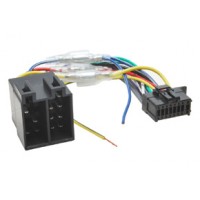Subwoofer JL Audio 10TW1-2
10", 300 W RMS, 82.5 dB (SPL 1W/1m), 2 Ω
More about the product
More about the product
We will help you with your purchase
- Use our consulting room
- You can return the goods to us within 14 days
- Try the product at our store
Subwoofer JL Audio 10TW1-2
The JL Audio TW1 subwoofers offer a combination of high performance, small mounting depth and very modest enclosure volume requirements. This makes them an excellent choice for very small and closed enclosures. The TW1 doesn't sound like regular subwoofers that you install in a small cabinet. The TW1s are optimized for the tightest of spaces yet deliver the rich depth and superbly controlled bass you've come to expect from JL Audio subwoofers. JL Audio's Concentric Tube Suspension technology compresses mounting depth to a minimum, providing excellent deflection capability and maximum performance potential. The TW1 also uses an ingenious frame design that is recessed so most of the forward deflection takes place within the dimensions of the frame. The result is a minimum front ground clearance of only 22 mm, even with the supplied grille installed. The recommended enclosure with a volume of only 18 L will allow operation in extremely confined spaces, for example under the seats of MPV vehicles, in the interior of sports cars and many other creative applications requiring a compact, low-profile subwoofer design.About the JL Audio brand
JL Audio is an American manufacturer of consumer audio equipment that specializes in home, vehicle and boat sound systems. It is one of the main pioneers of vehicle sound systems and is undoubtedly best known for its high-end subwoofers. The company was founded in 1975 and is therefore one of the oldest manufacturers in this field. The original focus was on home sound systems, but already at the turn of the seventies and eighties, they also started to deal with the car audio segment, the popularity of which grew rapidly at the time. During their rich history, JL Audio produced a lot of completely unique and patented subwoofers that had almost no competition at the time. And it is similar even now. Subwoofers from this manufacturer amaze with their performance and at the same time absolutely top sound quality, unique patents and excellent workmanship. In particular, the top W6 and W7 series have long been among the most interesting products on the market today. However, the revolutionary flat subwoofers of the TW1 and TW3 series, as well as the perfectly tuned subwoofer enclosures, will also impress. You can expect the same quality from the amplifiers, and it's also worth noting the high-end products designed for integration into factory audio systems. In short, you can't go wrong with JL Audio products and you can always rely on their high quality and uniqueness.
| Catalog number | 10TW1-2 |
| Brand | JL Audio |
| Links | Official web presentation (English) |
| RMS powerThe RMS power of the subwoofer is the constant power of continuous use of the subwoofer. If the power is exceeded for a longer period of time, irreversible damage may occur, or to burn out the voice coil of the subwoofer. | 300 W |
| Sensitivity (SPL 1W/1m)Subwoofer sensitivity or efficiency. The sensitivity of the subwoofer is given in decibels (dB) and, in simple terms, means that the higher the value, the lower the demands on the power of the amplifier. This is a de facto rating of how a subwoofer converts watts to sound. Sensitivity ratings are in noise level measured at 1 meter from the subwoofer using 1 W (watt of power) or using 2.83 volts at the source at 1 meter. A higher decibel level means the subwoofer is louder with less power. For every 3 dB increase in sensitivity, the subwoofer requires half the power to reproduce the same volume. For example, if an 88 dB subwoofer needs 300 watts to produce a certain volume, then a 91 dB subwoofer needs only 150 watts to reach the same efficiency. | 82.5 dB |
| ImpedanceImpedance - measurement of electrical resistance. When buying a subwoofer, it is very important that everyone make sure that the impedance matches the amplifier that you are connecting to it. For subwoofers with a double voice coil, we recommend following the information in the advice center! Example: A 2 Ohm subwoofer cannot be connected to an amplifier that is only stable up to 4 Ohms. A 4 Ohm subwoofer can easily be used on an amplifier that is stable up to 2 Ohms. Connecting a 4 Ohm subwoofer to an amplifier that is stable up to 4 Ohms also without problems. The most common subwoofer impedance is 4 Ohm. | 2 Ω |
| Subwoofer diameterThe diameter of the subwoofer is indicated on the screw holes. The overall outer diameter of the subwoofer is usually 1-2 cm wider, depending on the size category of the subwoofer. For a 30 cm subwoofer, the outer diameter incl. protective rubber 31.8 cm and in the 25 cm subwoofer it is 26.5 cm incl. protective rubbers. | 250mm (10") |
| Subwoofer mounting depthThe mounting depth of the subwoofer is measured from the bottom edge of the magnet to the bottom edge of the subwoofer's metal or cast basket. | 111 mm |
| Recommended enclosure volumeThe closed enclosure is characterized by a simple construction. Closed enclosures are usually smaller than bass-reflex enclosures, and a special damping fleece is used for their damping. A closed baffle has the advantage of preventing an acoustic short between the front and back radiation of the subwoofer diaphragm. The disadvantage is that the closed enclosure raises the natural resonance frequency of the used subwoofer and thereby also increases the lower limit frequency. This is because the back side of the diaphragm is forced to compress and dilute the air inside the enclosure when the subwoofer is radiating in a closed enclosure. This adds to the inherent stiffness of the subwoofer's oscillation system the stiffness of the air in the closed enclosure. This causes an increase in the stiffness of the oscillating system and thus an increase in the resonant frequency of the entire system: subwoofer -> loudspeaker. The increase in resonant frequency for a given subwoofer is greater, the smaller the volume of air in the closed enclosure. The relatively small volume of air in the closed enclosure acts on the subwoofer as an acoustic spring when radiating the back side of the membrane into the enclosed enclosure. USE: Mainly for quality bass listening in the entire band with an emphasis on detail and accurate reproduction in the lower band. Pros and cons: + pure reproduction + small closets + easier tuning - low level of efficiency in deep bass - loudness only at the cost of enormous deflection of the membrane - a significant acoustic pressure cannot be expected | 9.91 l |
| Recommended bass reflex speaker volumeA bass reflex enclosure is designed in the same way as a closed enclosure, but it also has a so-called bass reflex mouthpiece, or "bass reflex" or slot. Needle foam is used to dampen bass reflex enclosures. USE: The ideal use is in cases where the listener wants to achieve a high volume and a good sound pressure level. It is the best compromise between sound quality and performance and is also the most commonly used Pros and cons: + good efficiency in deep bass + a small deflection of the membrane is enough for a large volume - reproduction less accurate than with closed enclosures | 17.7 l |
| Fs - resonant frequencyFs - is the lower resonant frequency. This parameter is the de facto free air resonant frequency of the subwoofer. Simply put, it is the point at which the weight of the subwoofer's moving parts equals the force of the subwoofer's suspension while it is in motion. If you've ever seen a piece of string start to hum uncontrollably in the wind, you've seen the effect of reaching a resonant frequency. The weight of the moving parts and the stiffness of the suspension (surround and spider) are key elements that affect the resonant frequency. As a general rule, a lower Fs indicates a subwoofer that would be better at reproducing low frequencies than a subwoofer with a higher Fs. However, this is not always the case, as other important parameters of the subwoofer also enter the resulting sound. | 41.45 Hz |
| Vas - equivalent volume of airVas - represents the volume of air that, when compressed per cubic meter, acts with the same force as compliance (CMS), suspension in a certain subwoofer. Vas is one of the most complicated parameters to measure, as changes in air pressure are affected by conditions of relative humidity and temperature. Another way to describe what VAS is: try using a subwoofer and find a baffle that is the right size to return the air with the same stiffness to the same resonance. The size of this box is equal to you. There are, of course, other parameters, but they are not so necessary for the exact calculation of the enclosure. Resonance frequency and Q-parameter values are also important when building enclosures. | 10.31 l |
| Xmax + -Xmax - the maximum deflection of the subwoofer diaphragm in one direction – it is not a sum, or an abbreviation for the maximum linear deflection. The subwoofer output becomes non-linear as the voice coil begins to leave the magnetic gap. | 10 mm |
| QesElectrical Q-factor of driver is the electrical quality factor (electrical damping). If the subwoofer coil moves in a magnetic field, it generates its own current that counteracts its movement. Qes is a dimensionless parameter and the lower the number, the higher the generated current and the more damped the coil movement, thus reducing the total current flowing through the coil, the deflection and the sensitivity around the fs resonance. It varies in values from 0.08 to 0.6, in the extremes, for ordinary universal converters, even 20. Subwoofers with too low a Qes value, a very damped system, are not suitable for certain types of enclosures. | 0.696 |
| QmsMechanical Q-factor of driver is a mechanical factor of quality (mechanical damping). These are mechanical losses affecting (damping) the movement of the subwoofer membrane. Qms is a dimensionless parameter and the higher the number, the smaller the losses, i.e. the deviation and sensitivity in the lower band is also higher, it ranges around 0.4 - 25. | 9.7 |
| QtsTotal Q-factor of driver is a total quality factor, it includes both parameters Qes and Qms (electrical Qes and mechanical Qms). It varies in values from approx. 0.08 to 0.6, exceptionally up to 3. The Qts of the subwoofer is calculated in the same way as, for example, a pair of parallel resistors, so the result is decisively influenced by a smaller value that cannot be exceeded, which is usually Qes. | 0.649 |
Product comments
Evaluation
ask us

























